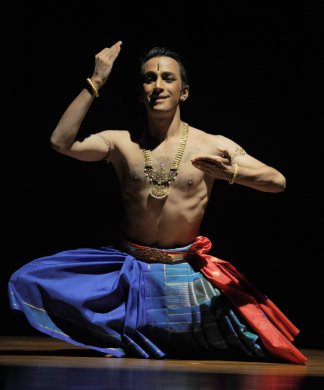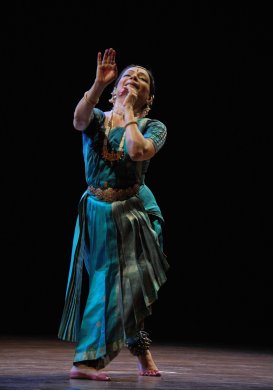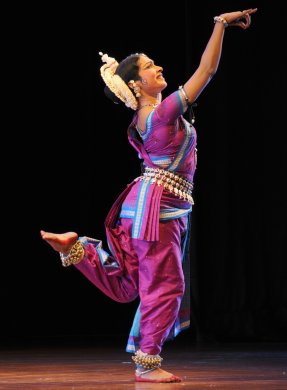
|   |

|   |
The Madras Music Academy Dance Festival - Day 4 - Veejay Sai e-mail: vs.veejaysai@gmail.com Photos: Thanthoni January 12, 2017 The promise of Kalakshetra The fourth morning of the Academy festival opened with a solo performance by Christopher Gurusamy. Christopher is a graduate of Kalakshetra. For the last few years he has been performing in Guru Leela Samson’s group Spanda. Last year he was the winner of the ‘HCL competition’ for being the best dancer. This show was his debut at the prestigious Academy festival.  Christopher began his performance with a virutam “Sakala kala valli” set to ragam Khamas in praise of goddess Saraswati. This continued into a simple alarippu set to khanda chapu talam. If this worked as a simple warm up, he continued his performance into the main piece, the famous “Saami ninne kori” varnam by Ponnaiah Pillai of the Tanjore Quartet. This oft-performed varnam is a good challenge a debutante dancer can throw himself into, especially while presenting it in a festival of this stature. The anxiety of the first time performance was visible through the first half of the varnam. We saw the nayika pick flowers, make garlands and other sancharis to lines “Sada neeve nannelu koraa.” It took Christopher some time to warm up and he finally did! With clean lines, crisp nritta and a fantastic energy about his dance, Christopher’s performance only got better. The second half of his varnam was excellent. By the time he did “Saati leni kalyaani,” the audience saw his left foot bleeding, having been roughed up by the pressure of his ankle bells. But the clear anchita and kunchita paada bhedas that shone were impressive. Using the entire expanse of the dream stage that Academy offers, Christopher’s nritta was a delight to watch just as much as Sudarshini Iyer’s excellent nattuvangam kept him inspired to dance. This is what one expects from a dancer of his age. The energy of his nritta made up for the lack of his mukhaja abhinaya. If he works a little more on his facial expressions, he can easily be one of the best graduates Kalakshetra has produced in a long time. Christopher continued his performance with an ashtapadi from the Gita Govindam. In the seventh ashtapadi “Maamiyam,” Krishna laments at the absence of Radha. This is one of the few instances to see the viraham, or pangs of separation of Krishna in the entire text. Christopher’s attempt, albeit with a static face, was honest and heartfelt. Nandini Anand Sharma, who has a sweet singing voice ended up making several bleeping errors in her pronunciation of the Sanskrit verses. He followed this with the famous English Javali “Oh my lovely Lalana” written by Karur Sivaramayya, set to Kharaharapriya ragam, choreographed by Bragha Bessell. Smart choreography, some good ideas and Christopher’s own enthusiasm were visible through this piece. Christopher concluded his performance on a note that most of us took a while to register. It was exactly this day that the great Rukmini Devi Arundale founded Kalakshetra, eighty one years ago! As a tribute to her, Christopher danced to the famous thillana in ragam Bilahari composed by the musical genius M.D. Ramanathan who was on the payroll of Kalakshetra. A prayer to goddess Tripurasundari Devi of Thiruvanmiyur to protect this ambitious project, the thillana had the fragrance of innocence and old world charm, both of which are a rarity now. What a fitting and well thought out tribute to his alma mater! Christopher proved to be a worthy inheritor and a proud graduate of Kalakshetra. The institution has given us very few male soloists in the last eighty years of its existence. If Christopher can fine tune some elements of his dance to better perfection, he can be a fantastic soloist to look forward to. He is a star in the making and one must wait and watch his journey towards greater heights in his artistic career. Bharatanatyam inspired by Manipuri? The second performance of the morning was by Anjana Anand, an alumnus of the Singapore Indian Fine Arts Society, and a diploma holder from Kalakshetra, now training with Sheejith Krishna, a veteran dancer turned teacher who also conducted the nattuvangam for this show.  Anjana began her performance with “Nyairu,” a composition of poet Subramanya Bharati in praise of the sun god, set to a ragamalika and talamalika. The first thing that was visible was her odd looking costume. Like a fading Apsara who might have had a wardrobe malfunction from an old Tamil movie, she was dressed in a costume that no one understood. There were dupatta ends hanging behind her shoulders and an extra waistband. All in different colours that only added to make her look like her back was hunched. Her main piece was the Swati Thirunal varnam “Sarasa Shara Sundara”, set to ragam Neelambari and adi talam. The choreography of it was by Sheejith Krishna. For most of the varnam, Anjana stood in one place, like she was glued to that part of the stage and danced. With a large expanse of the stage to her left and to her right, Anjana stood stranded in the middle. What kind of choreography was this? Was it inspired by Manipuri? Manipuri surely has far more grace even if the physical execution of it is so contained within a small space. If the dance was bad enough, the music didn’t get any better. Savita Narasimhan’s singing was strained and one could see her totally stressed out. Her bad Sanskrit pronunciation added to this. Several lines were misinterpreted in her sancharis. For “Sharada ritu” (season), Savita kept repeatedly singing “shaaradaa” which completely distorted the meaning. For “Paalita Sheshaloka” which means ‘one who nurtures the whole world’, Anjana kept depicting the visual of ‘Sesha’ the snake on which Vishnu sleeps. Sanskrit is a very sensitive language. Stretching a syllable or turning a phrase can completely change the meaning. Singers who aren’t familiar with the nuances of the language must avoid singing it in public. Savita made a mess of the Sanskrit and Anjana’s dance reflected that. Anjana continued her performance with “Netru varen endru,” a padam by Subbarama Iyer set to Panthuvarali ragam and misra chapu talam. The nayika here is complaining to her friend about her hero who promised to arrive the earlier day but didn’t show up. She goes on to lament about the fact that she didn’t make good use of the time she was with him at an earlier occasion. Anjana ended the padam with an anti climax. Showing a honeybee hovering over a flower, to show the nayika’s doubt on her hero’s excitement with another woman, Anjana did the opposite. The sense of lament and poignancy were missing in her abhinayam. Anjana too ended her performance with a thillana in memory of Rukmini Devi. Choreographed by Rukmini Devi herself, in the original, the thillana composed by Veena Krishnamachariar was in Natabhairavi ragam and adi talam. However, none of Rukmini’s vibrant choreography came through in this as Anjana decided to present it with her mentor Sheejith’s constricted choreography instead. On one morning we got to see what the dance of Kalakshetra style could be if presented well and the other side of it. Anjana’s dance didn’t do any justice to her claim as a product of this prestigious institution. She has to work on several things at this point - her basic stance, her facial expressions, her nritta and more. She has a while to go before she can emerge as a confident soloist. Queen of retrospectives This year’s Natya Kala Acharya awardee Malavika Sarukkai presented a solo in the evening. She decided she would revisit some of her older works and perform a retrospect. This was a great idea except that she has always been performing the same things over and over again, the last few seasons.  Malavika began her performance with a piece titled ‘Trayodbhavam.’ Opening with a slokam in ragam Hamsadhwani and flowing into a Dhrupad of Miyan Tansen, ‘Vishnu charana jala Brahma’ in ragam Revagupti, this was an excerpt from her older work on Ganga which she presented in ‘Vaahini’ seven years ago. Did this piece have any new choreography? None of that was visible! She continued into the Tanjore Quartet varnam “Saami ninne kori.” She has performed this very varnam couple of seasons ago in this same festival and in the same slot. There was a major disconnect between her and the mridangam artiste Nellai Balaji. At various points in the varnam, both had to make embarrassing adjustments on stage, though Srilatha’s nattuvangam was fantastic. “Prema meeraga thanjapuri vaasa” the nayika said showing us the grand temple of Thanjavur. And we saw Malavika hug Brihadeeshwara! Really?! Anyone who has seen the size of Brihadeeshwara inside the temple would think twice to enact sanchaaris like this! Only the same morning we saw young Christopher Gurusamy perform the same varnam with much enthusiasm. Malavika, with years of experience in the field, could have easily presented any other varnam. ‘Ichcha’ based on the life of eco activist Salumarada Thimakka who grew to fame planting banyan trees on the outskirts of Bangalore, is a work Malavika has been presenting for the last fifteen years. It is also a part of her ‘Vaahini’ DVD that she released a few years ago. Overdramatized choreography showed Thimmakka digging mud pits, kissing seeds before planting them into the earth. We saw a shade of what Malavika interprets as ‘Treeness’, which is not exactly becoming a tree, but not unbecoming either! This melodrama continued into the next piece, the famous ashtapadi “Sakhi he.” The viraham of the nayika, which is the essence of this poem, was not conveyed sufficiently nor did the choreography invoke it in any way. Malavika concluded her performance with a Tarana in ragam Puriya Dhanashri composed by veteran Guru C.V. Chandrasekhar. The choreography of this saw her pacing up and down the stage, mostly walking around. Murali Parthasarathy’s singing, strained in places, was still melodious when combined with Srilakshmi Venkataramani’s violin accompaniment. Malavika, being this year’s awardee of the prestigious Natya Kala Acharya, at least for the sake of honouring the award, could have presented one new work, one new choreography, one new varnam or anything she is good at. It would have brought in a great deal of freshness to her performance. Veteran divas like Malavika have great responsibility in the way they perform and how and what they perform. Thousands of students of dance look up to them. Whatever they do comes under high scrutiny, by default. Both the good and bad get magnified in the process. A poetic stillness  Unlike every year when the last slot of the day is usually a group performance, this year the Academy festival programmed several senior soloists. The first of these began with a solo performance by Odissi diva Sujata Mohapatra. Unlike what was announced in the list, Sujata began her performance with the Kirawani Pallavi. Without the signature opening of ‘Jagannatha Swami Nayanapathagaami’, it felt a bit odd. Set to khemta taal of six beats this is a classic choreography of Guru Kelucharan Mohapatra with music composed by Pt Bhubaneswar Mishra. To open a recital with a totally abstract piece was probably a challenge Sujata wanted to throw herself into. It was a delight to watch her footwork as Ekalabya Muduli played the mardala and recited the bols with his soft voice. She continued her performance with ‘Varsha’. Excerpted from the writings of the famous Sanskrit poet and playwright Kalidasa’s ‘Ritusamharam’, it was a celebration of nature. With beautiful music by Pt Raghunath Panigrahi and choreography by Ratikant Mohapatra, the piece was presented in great detail with depiction of rain clouds like elephants, the agony of lovers in separation and more to show a mood of the season. On the other side was the brightness of nature in its joyful forms. Peacocks dancing, forest birds and animals and the greenery around. Surmani Ramesh Chandra Das’s exceptional violin music to show the crying of a peacock enhanced the piece. In one piece we got to see how nature and rains can be both good and bad through brilliant choreography. A classic Kelubabu piece “To lagi gopo dondo” set to khemta taal and Shankarabharanam ragam enumerating the leelas of Krishna and Radha’s dialogue with him was the next piece. At her playful best we saw Sujata perform the sancharis to “Madhura latako dhadhi bhikki kore,” with great ease. What is an Odissi performance without Gita Govindam? We saw the pain of a khandita nayika in Sujata’s presentation of “Yahi Madhava, Yahi Keshava.” Once again the beauty of Kelubabu’s choreography! She concluded her performance with ‘Jai Mahesha’, a piece in praise of lord Shiva. This was an unusual performance in many ways. It didn’t have the predictable beginning of the invocation. Nor did it end with a Mokshya which is like the Mangalam in an Odissi recital. What came forth was a poetic stillness of a dancer who is greatly invested in her own art. Veejay Sai is a writer, editor and culture critic. |